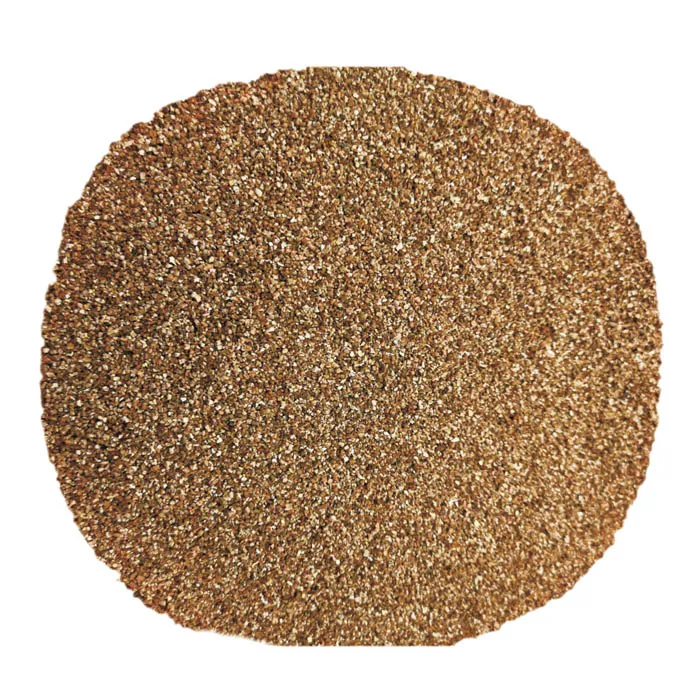Apr . 23, 2025 10:35 Back to list
Vermiculite for Container Gardening: A Must-Have Solution
Growing plants in containers can be challenging, especially when it comes to maintaining proper moisture, aeration, and nutrient availability. This is where vermiculite in soil becomes a game-changer. By adding vermiculite to soil, you can create the perfect growing environment for your container plants. Whether you're growing vegetables, flowers, or herbs, gardening vermiculite improves soil structure and promotes healthy root development.

Why Use Vermiculite in Soil for Container Gardening?
Container plants face different challenges compared to garden plants. Since pots dry out quickly and have limited soil, using vermiculite in soil helps balance moisture, aeration, and nutrients.
Moisture Retention Without Overwatering
One of the biggest benefits of gardening vermiculite is its ability to hold moisture while preventing waterlogging. Unlike regular soil, vermiculite absorbs water and slowly releases it, keeping plant roots hydrated for longer periods.
Improves Soil Aeration for Healthy Roots
Plant roots need oxygen to grow properly, but compacted soil can restrict airflow. Adding vermiculite to soil creates a light, fluffy texture that allows roots to expand freely and absorb nutrients efficiently.
Reduces Nutrient Loss
Watering container plants can lead to nutrient runoff. Vermiculite in soil helps retain essential minerals, ensuring that plants get the nutrients they need for strong growth.
How to Use Vermiculite for Container Plants
Incorporating vermiculite plants into your container gardening routine is simple and effective. Follow these steps for the best results.
Step 1: Mix Vermiculite with Potting Soil
For optimal results, mix gardening vermiculite with a high-quality potting mix. A recommended ratio is:
- 40% potting soil
- 30% compost
- 30% vermiculite
This blend provides excellent moisture retention, drainage, and nutrient retention.
Step 2: Fill Containers with the Mix
Ensure your pots have drainage holes to prevent excess water buildup. Fill them with the prepared vermiculite plants mix, leaving some space for root growth.
Step 3: Plant and Water
Once you've placed your plants or seeds in the soil, water thoroughly. Vermiculite in soil will absorb moisture and gradually release it to the roots, reducing the need for frequent watering.
Step 4: Maintain with Occasional Top-Dressing
Over time, container soil can become compacted. To refresh it, sprinkle a thin layer of gardening vermiculite on the surface and lightly mix it in.
Best Plants to Grow with Vermiculite in Containers
While vermiculite plants benefit from improved soil conditions, some plants thrive exceptionally well with this addition.
Herbs and Leafy Greens
Herbs like basil, cilantro, and mint, as well as leafy greens like spinach and lettuce, grow well in a vermiculite in soil mix. The moisture-retaining properties keep these plants hydrated without overwatering.
Flowering Plants
Flowers such as petunias, marigolds, and geraniums enjoy well-aerated soil. Adding vermiculite to soil helps their roots develop properly, resulting in healthier blooms.
Vegetables in Containers
Tomatoes, peppers, and cucumbers thrive with gardening vermiculite. Their roots need aeration and moisture balance, which vermiculite provides perfectly.
Choosing the Right Vermiculite for Gardening
Not all gardening vermiculite is the same. Choosing the right type ensures maximum benefits for your container plants.
Fine or Medium Grade for Small Plants
Fine or medium-grade vermiculite plants work best for delicate herbs and seedlings, as they retain moisture efficiently and improve root development.
Coarse Grade for Larger Plants
If growing vegetables or flowering plants, use coarse vermiculite in soil to enhance aeration and drainage.
Organic and Chemical-Free Options
Always choose high-quality, chemical-free gardening vermiculite for healthier plants, especially if growing edible crops.
Vermiculite for Container Gardening: FAQs
Can I use vermiculite alone for container plants?
While vermiculite plants benefit from moisture retention, it’s best to mix vermiculite with potting soil or compost for proper nutrition and drainage.
How much vermiculite should I add to my potting mix?
A mix of 30% gardening vermiculite, 40% potting soil, and 30% compost creates an ideal growing environment for most container plants.
Does vermiculite improve plant growth?
Yes! Adding vermiculite to soil enhances aeration, retains moisture, and reduces nutrient loss, leading to stronger root systems and healthier plants.
Is vermiculite safe for organic gardening?
Yes, vermiculite in soil is natural and safe for organic gardening. Just ensure that you use a high-quality, chemical-free product.
Can I reuse soil with vermiculite?
Yes, you can refresh old soil by mixing in new gardening vermiculite to restore moisture retention and aeration properties.
Enhance your container gardening success with high-quality vermiculite! Order now and give your plants the perfect growing conditions.
-
Strength with Premium Steel and Calcined Bauxite
NewsJul.28,2025
-
Revolutionize Construction Efficiency with Smart Industrial Materials
NewsJul.28,2025
-
Redefined with High-Grade Iron Powder Solutions
NewsJul.28,2025
-
Metallurgical Efficiency with Innovative Recarburisers and Covering Agents
NewsJul.28,2025
-
Industrial Efficiency Enhanced with High-Performance Recarburizer Solutions
NewsJul.28,2025
-
Boosted by Advanced Iron Powder and Carbon Additive Solutions
NewsJul.28,2025
